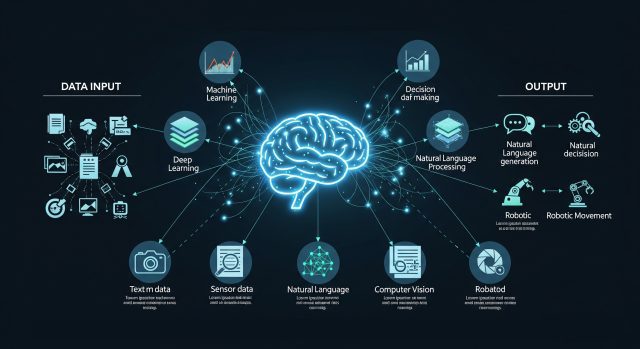Artificial Intelligence is not just a futuristic concept — it already exists in many things we use daily, often without us even realizing it. From voice assistants on smartphones to personalized shopping recommendations and navigation apps, AI is quietly working in the background to make our lives easier.
But how does it actually work? Despite sounding complicated, the basics of AI can be explained in simple, clear steps. In this guide, we break down the process into 10 easy-to-understand stages, from gathering data and recognizing patterns to training algorithms and making decisions.
Whether you are completely new to AI or just curious about the systems shaping modern technology, this explanation will give you a clear and practical understanding. By the end, you will see how machines learn and why AI has become one of the most powerful tools of our time.
1. Collect Data
Every Artificial Intelligence system starts with data, and lots of it. Data can come in many forms such as text, numbers, spreadsheets, images, videos, or audio recordings. Think of data as the fuel that powers AI. Without it, no AI system can learn, adapt, or make decisions.
For example, if you want to build an AI that can recognise cats in photos, you will need thousands, if not millions, of images of cats as well as other objects for comparison. The more varied and balanced the dataset, the better the AI becomes at recognising the right patterns.
The quality of data is just as important as the quantity. Clean, accurate, and relevant data helps AI systems develop smarter, more reliable predictions. On the other hand, poor or biased data can lead to weak or misleading results. This is why data collection is often the most time-consuming step.
2. Clean & Prepare the Data
Once data has been collected, the next step is to clean and prepare it for use. Raw data is rarely perfect. It often contains errors, missing values, duplicates, or irrelevant details that can confuse an AI system. If the data is not properly organised, the AI may learn the wrong lessons and produce inaccurate results.
Data preparation involves sorting, filtering, and structuring the information so the AI can process it efficiently. For example, numbers may need to be standardised, images may require resizing, and text might have to be simplified or reformatted consistently.
High-quality preparation is critical because even the most advanced algorithms cannot perform well with messy inputs. Clean and accurate data gives AI the foundation it needs to learn properly, recognise patterns, and make trustworthy predictions in real-world situations.
3. Choose an Algorithm
With clean data ready, the next step is selecting the right algorithm. An algorithm is essentially a set of instructions that guides the AI on how to process and learn from the data. The choice of algorithm depends on the problem being solved.
For example, if the goal is to predict house prices, a regression algorithm might be best. If the AI needs to classify emails into spam or not spam, a classification algorithm is more suitable. When recognising objects in photos, neural networks are often the go-to choice.
Choosing the right algorithm is important because it directly impacts how effectively the AI can learn. A poor choice may lead to slower results or limited accuracy, while the right one can unlock the full potential of the data. This step sets the stage for training the model and ensuring that the AI can handle the task at hand.
4. Train the Model
Training is where the AI begins to learn from the prepared data. During training, the data is fed into the algorithm repeatedly, allowing the system to adjust its internal settings and discover useful patterns.
Think of it like teaching a student with flashcards. The AI is shown examples again and again until it begins to understand the relationships within the data. For instance, when training an AI to recognise dogs in photos, it is given thousands of labelled examples of dogs until it can spot the key features on its own.
The more training the AI receives, the better it becomes at making accurate predictions. However, training requires careful balance. If an AI learns too little, it will be inaccurate. If it memorises everything too closely, it may fail to work well on new data. Training is about finding the right middle ground.
5. Learn from Patterns
As the model trains, it begins to adjust itself based on patterns in the data. This process involves fine-tuning internal parameters, often called weights, that help the AI make better predictions.
For example, when learning to identify handwritten numbers, the AI gradually figures out which shapes and curves are most important. It does not memorise each example but instead learns the general patterns that distinguish one number from another.
This stage is powerful because it transforms raw information into meaningful insights. The AI starts to move beyond simply processing data and instead begins to understand relationships and structures within it. By learning patterns, AI systems can later apply this knowledge to new, unseen data and still perform well.
6. Test the Model
Once the AI has been trained, it needs to be tested. This step ensures the model can handle new data it has never seen before. If it performs well on test data, it shows that the AI has genuinely learned rather than memorised.
Testing is usually done with a separate dataset that was not used during training. For instance, if an AI was trained with 80 percent of the available data, the remaining 20 percent might be saved for testing. This provides a clear picture of how the system performs in realistic conditions.
The results of testing highlight strengths and weaknesses. If the AI performs poorly, it may need more training or a different approach. If it performs well, it is ready to move to the next stage. Testing is essential because it ensures accuracy and reliability before the AI is used in the real world.
7. Adjust & Improve
No AI model is perfect after its first round of training and testing. Adjustments are often necessary to improve performance. Developers may fine-tune algorithms, add more data, or change certain settings to get better results.
This process is similar to coaching an athlete. With feedback and practice, performance gradually improves. For AI, improvements can come from cleaning data further, tweaking model parameters, or even switching to a more suitable algorithm.
Continuous adjustment helps prevent problems like overfitting, where the AI performs well on training data but fails in new situations. By refining the system, developers ensure the AI becomes more accurate, adaptable, and useful in real-world applications. This stage highlights the importance of patience and iteration in building truly intelligent systems.
8. Deploy the AI
After testing and improvement, the AI is finally ready to be deployed. Deployment means putting the system into action for real-world use. This could be as part of a chatbot, a recommendation engine, a medical scanner, or even a self-driving car.
Deployment connects the AI model with users and practical tasks. For example, a recommendation algorithm might be integrated into a shopping website to suggest products. A vision model might be placed inside a security camera to detect unusual activity.
Deployment is a critical stage because it shows whether the AI can handle real-time situations. It also reveals how people interact with the system. Successful deployment depends on strong testing and careful preparation, ensuring the AI can perform reliably outside of a controlled environment.
9. Get Feedback
Once an AI system is deployed, feedback becomes the key to further improvement. Feedback can come from user interactions, performance metrics, or direct evaluations of the system’s accuracy.
For example, if a voice assistant misunderstands commands, users can correct it, and that feedback is used to make the system smarter. Similarly, if a recommendation engine suggests irrelevant products, the system can track user behaviour and adjust future recommendations.
Feedback ensures that AI does not remain static but instead adapts and grows in effectiveness. It allows developers to spot weaknesses, fix errors, and improve user satisfaction. Without feedback, an AI system risks becoming outdated or less useful over time.
10. Keep Learning
The final step in the AI process is continuous learning. Artificial Intelligence is not a one-time project but an ongoing journey of improvement. With new data, updated feedback, and changing conditions, AI systems keep refining their abilities.
For example, language models constantly learn from new words and trends, while medical AI systems improve as new research and patient data become available. This process ensures that AI remains relevant and reliable in a rapidly changing world.
The ability to keep learning is what makes AI so powerful. Unlike traditional software, which stays the same unless manually updated, AI evolves naturally. The more it learns, the more accurate and helpful it becomes. Continuous learning is what transforms AI from a tool into a truly intelligent partner.



